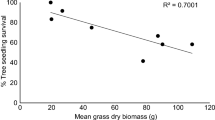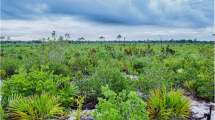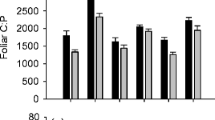Summary
Diverse populations of ephemeral herbs form the dominant element of community biomass in the first year of growth following a fall burn in chamise chaparral. Ephemeral herbs constituted 337 kg ha-1 of above-ground biomass after the first season of post-fire growth. This was 64% of the total, with the majority of the remaining biomass being in resprouts of Adenostoma fasciculatum. Ephemeral herb biomass following fire in other stands was as high as 1117 kg ha-1. Nutrient contents of ephemeral herbs were 6.68 kg N ha-1, 0.71 kg P ha-1, 10.05 kg K ha-1, 4.75 kg Ca ha-1 and 0.91 kg Mg ha-1. These were 55, 54, 81, 71 and 70% respectively of the above-ground totals. In the second year following fire, the total herb biomass was 40% higher, but the nutrient pool in above-ground biomass of these herbs was only 30–60% of what it had been the first year. Resprouts of A. fasciculatum and short-lived wood shrubs constituted more than 90% of above-ground biomass at this stage of postfire succession.
Similar content being viewed by others
References
Blank JL, Olson RK, Vitousek PM (1980) Nutrient uptake by a diverse spring ephemeral community. Oecologia (Berlin) 47:96–98
Christensen NL, Muller CH (1975) The relative importance of factors controlling germination and seedbed survival of Adenostoma chaparral. Amer Midland Nat 93:71–78
Horton JS, Kraebel CJ (1955) Development of vegetation after fire in the chamise chaparral of southern California. Ecology 36:244–262
Keeley S, Johnson AW (1976) A comparison of patterns of herb growth in comparable sites in Chile and California. Amer Midland Nat 97:120–132
Muller RN, Bormann FH (1978) Role of Erythronium americanum Ker. in energy flow and nutrient dynamics of a northern hardwood forest ecosystem. Science 193:1126–1128
Muller CH, Hanawalt RB, McPherson JK (1968) Alleopathic control of herb growth in the fire cycle of California chaparral. Bull Torrey Bot Club 95:225–231
Parsons DJ (1976) The role of fire in natural communities: An example from the southern Sierra Nevada, California. Envir Conserv 3:91–99
Peterson DL, Rolfe GL (1982) Nutrient dynamcis of herbaceous vegetation in upland and floodplain forest communities. Amer Midland Natur 107:325–339
Rundel PW (1981) Fire as an environmental factor. In: Lange OL, Nobel P, Osmond CB, Ziegler H (eds) Physiological Ecology, Vol. A: Interaction with the Physical Environment. Springer, Heidelberg, pp 501–559
Rundel, PW (1983) The impact of fire on nutrient cycles. In: Kruger FJ, Mitchell OT, Jarvis JUM (eds) Mediterranean-type Ecosystems — The Role of Nutrients. Springer, Heidelberg (pp 192–207)
Sweeney JR (1956) Responses of vegetation to fire. Univ Calif Publ Bot 28:143–250
Vogl RJ, Schorr PK (1972) Fire and manzanita chaparral in the San Jacinto mountains, California. Ecology 53:1179–1180
Author information
Authors and Affiliations
Rights and permissions
About this article
Cite this article
Rundel, P.W., Parsons, D.J. Post-fire uptake of nutrients by diverse ephemeral herbs in chamise chaparral. Oecologia 61, 285–288 (1984). https://doi.org/10.1007/BF00396774
Received:
Issue Date:
DOI: https://doi.org/10.1007/BF00396774




